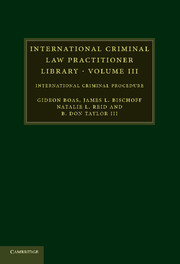Book contents
- Frontmatter
- Contents
- Foreword
- Table of authorities
- Table of short forms
- 1 The nature of international criminal procedure
- 2 Creation and amendment of rules of international criminal procedure
- 3 Procedures related to primacy and complementarity
- 4 Investigations, rights of suspects, and detention
- 5 Defence counsel, amici curiae, and the different forms of representation of accused
- 6 Pre-trial proceedings
- 7 Trial proceedings
- 8 The role and status of victims in international criminal procedure
- 9 Evidence
- 10 Judgement and sentencing
- 11 Appeal and revision
- 12 Conclusion
- Index
- References
2 - Creation and amendment of rules of international criminal procedure
Published online by Cambridge University Press: 05 August 2011
- Frontmatter
- Contents
- Foreword
- Table of authorities
- Table of short forms
- 1 The nature of international criminal procedure
- 2 Creation and amendment of rules of international criminal procedure
- 3 Procedures related to primacy and complementarity
- 4 Investigations, rights of suspects, and detention
- 5 Defence counsel, amici curiae, and the different forms of representation of accused
- 6 Pre-trial proceedings
- 7 Trial proceedings
- 8 The role and status of victims in international criminal procedure
- 9 Evidence
- 10 Judgement and sentencing
- 11 Appeal and revision
- 12 Conclusion
- Index
- References
Summary
Two of the notable differences among the various international criminal tribunals are the manner in which their respective procedural architectures are created, and the constitutional frameworks for their amendment. Though the legitimacy of international criminal procedure as a body of law has begun to receive more academic attention, an infrastructural issue of considerable significance to the debate remains relatively unexplored: how rules and regulations that bind parties and courts (and indeed, states, international organisations, and individuals through orders of these courts) are created and amended.
The judges of the ICTY and the ICTR (jointly, ad hoc Tribunals) have a unique, and now well entrenched, power to create and amend their own rules as ‘quasi-legislators’. The drafters of the Rome Statute, however, rejected such an approach, opting instead for greater control of the procedural framework by the Assembly of States Parties (ASP) – an approach reflected more in form than in substance, as discussed below. Diversifying further the rule-making frameworks, the internationalised tribunals have opted either for the largely wholesale adoption of the ICTY or ICTR Rules, as in the case of the SCSL; or the application of the rules of domestic courts, in the cases of the Cambodian Extraordinary Chambers and the now-defunct East Timor Special Panels.
This chapter discusses the manner in which rules of procedure and evidence have been created and how they are amended in the different international criminal tribunals.
- Type
- Chapter
- Information
- International Criminal Law Practitioner LibraryInternational Criminal Procedure, pp. 21 - 45Publisher: Cambridge University PressPrint publication year: 2011



